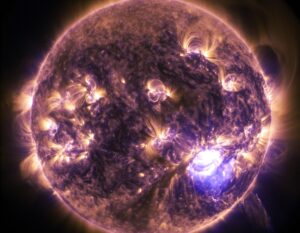In this section, we will explore how the big bang eventually led to the formation of the first hydrogen and helium atoms. We will discuss the following:
- Big Bang
- Fundamental Forces
- Fundamental Particles
- First Atoms
- Cosmic Background Radiation
Preview: 3D Model of Hydrogen and Helium atoms
Consider something unbelievably tiny, unbelievably dense, and incredibly hot. Then, suddenly, space, time, and all molecular matter burst in ways that no words can express. What is known is that the Universe expanded at an unfathomable rate in a fraction of a second. Some recognised subatomic particles and fundamental forces emerged as a result of this expansion. The Universe then began to cool drastically, to around 1 billion degrees Celsius, allowing energy and, ultimately matter to emerge.
The shortest period of time with any physical meaning. It is the smallest time interval that can be measured. The Planck time denotes the scale beyond which present physics theories fail.
The universe expanded at an inconceivable speed, from far less than an atom to enormous size.
The fundamental forces: Gravity (the force that pulls everything together), Electromagnetism, weak, and strong interaction (the force that holds nuclei together) emerged.
Quantum fluctuations produce the microscopic 'wrinkles' in density that keep the universe from becoming completely uniform and homogeneous. This paved the path for subatomic particles like quarks to be formed.
The expansion had relatively slowed down. Due to quantum fluctuations subatomic particle like quarks were formed which were the building blocks of protons and neutrons. Quarks and antiquarks formed and annihilated each other. The remaining quarks accounted for one billionth of the prior mass of quarks and antiquarks.
Electron-positron pairs were created and annihilated, leaving 1/billionth the amount of electrons and positrons behind.
Quarks combined to generate protons and neutrons. Two up quarks and one down quark make up a proton, while one up quark and two down quarks make up a neutron.
As the universe cooled, these neutrons and protons combined further to form hydrogen and helium nuclei. The hydrogen nuclei contained only a single proton while helium nuclei was made up of two protons and two neutrons. Deuterium, Helium-3, and lithium-7 were also formed in trace amounts.
The universe consisted of plasma (superheated state of ordinary matter) of nuclei, electrons, and photons; temperatures were too high for electrons to attach to the nuclei. Because photons of light were tangled up in these charged particles, they couldn't flow freely through the universe. Hence, the universe was utterly Dark.
As the universe expanded, plasma grew cooler and cooler. The universe cooled down further to 3000 K, making it possible for the nuclei in the plasma to gain electrons and become full-fledged neutral Hydrogen and Helium atoms.

Photons of light tangled in the plasma could now move freely and were released. The universe became transparent for the first time. This is known as cosmic microwave background that we can see even today.

Time is Up!

Time’s up

